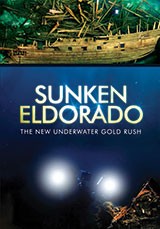
Sunken Eldorado: The New Underwater Gold Rush 2019
Distributed by Green Planet Films, PO Box 247, Corte Madera, CA 94976-0247; 415-377-5471
Produced by Via Decouvertes
Directed by Denis Delestrac and Didier Martiny
Streaming, 52 mins
High School - General Adult
Global Issues; Marine Sciences; Political Science
Date Entered: 07/27/2020
Reviewed by Carolyn Klotzbach-Russell, Social Sciences Librarian and Government Information Librarian, University at Buffalo Libraries, State University of New York at BuffaloComparing itself to other historic races for precious resources, Sunken Eldorado: The New Underwater Gold Rush, is a reminder of our innate human desire to explore and conquer our planet. With autonomous underwater vehicles paving the way and the ability to use technological advancements to map the seabed, humans can now travel virtually to the bottom of the world’s oceans and recover vessels sunk for hundreds of years. Gold, jewels, porcelain, and artifacts - a fortune stands to be made from recovering these items, but are they a nation’s cultural heritage or trade goods?
Although this film is multi-disciplinary in nature, its main focus revolves around who has the right to claim the recovered goods and materials found in the estimated 3 million shipwrecks across the world's ocean. Since oceans are considered international waters, many questions whether the finder, funder, or country of origin should lay claim. When vessels are recovered by treasure hunters, governments have stepped in and legal battles, like the one between the company Odyssey Marine Exploration and the country of Spain, determine who can lay final claim. Although cases tend to rule in favor of the country of origin, the fact remains that many governments do not have the millions of dollars required to excavate and safeguard the site. By interviewing ocean archeologists, treasure hunters, wreck recovery companies, The United Nations Educational, Scientific and Cultural Organization (UNESCO), and government experts, Sunken Eldorado presents a balanced viewpoint of the interested parties well and stays relatively unbiased towards any group.
The film also does a solid job in providing a brief historic context to these vessels and addressing the often painful and sensitive origins of how these minerals were acquired in the first place (e.g. through ransacking of tombs, genocide, and slave labor mining). It is a necessary part of the film and one that must be included when debating recovery of goods from the age of European exploration.
One frustrating aspect of the topic portrayed by the film is that the issue of wreck recovery is not a priority for governments at this time, nor is it likely to be in the near future. Possible success is posed as a blend of commercial, government, and scholarship but there is currently no satisfactory partnership that makes this solution a reality. The viewer is left wondering as to what the fate of these vessels will be.
This film would pair well with lessons in political science, geography, archeology, history, business and economics, and could lend well to multidisciplinary discussion and collaboration at the college level. An engaging, fast-paced film that, at 52 minutes, is a light lift to viewers, Sunken Eldorado is recommended to educators at a high school or college level, as well as the general public.